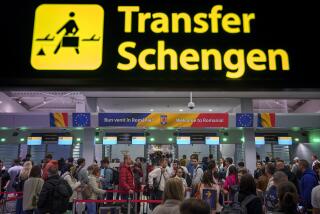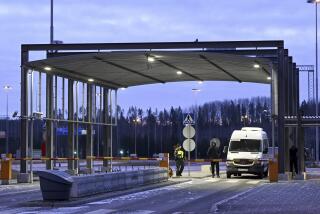Explore caves. Scale 6th century fortress walls. Savor fresh-caught fish. The pleasures of barely discovered Macedonia.
Macedonia, a landlocked Balkan country squeezed between Bulgaria, Serbia, Greece, Albania and Kosovo, is one of Europe’s best surprises.
Part of the former Yugoslavia until its independence in 1991, it is an exotic melting pot of civilizations at the crossroads of East and West.
Wildly mountainous with spectacular rivers, peaks and national parks, it is also rich with the cultural mementos of a long, turbulent history of invasions and occupations by Persians, Romans and Ottoman Turks.
See the most-read stories in Life & Style this hour >>
Roughly the size of Vermont, Macedonia (pronounced locally “Mack-edonia”) today has a parliamentary democracy and is a safe, friendly and inexpensive country in which to travel. Best of all, with tourism in its infancy, it is still charmingly unpretentious and warmly welcoming.
That also means it’s wise to expect minor logistics hiccups as it is still a developing country, one of Europe’s last undiscovered destinations that almost no one — not even Western Europeans who flock to nearby Croatia— has visited.
Its official name is the Former Yugoslav Republic of Macedonia due to continuing protests from Greece about using “Macedonia” because it has a region with the same name.
I visited Macedonia for a week in May for a cultural immersion in both the capital city of Skopje (“skop-yeah”) and the historic UNESCO World Heritage town of Ohrid, at the opposite end of the country, to sample tasty traditional cuisine that hints at Greek and Turkish influences and sip the country’s fine local wines and fiery rakias, or fruit brandies.
Macedonia’s easily accessible wilderness is custom-made for outdoor activities, so I also threw myself into hiking, easy rock climbing, mountain biking, caving and paddling at the hands of knowledgeable, certified guides, a good idea in a country with undecipherable Cyrillic writing and limited English speakers outside of the main cities.
The tales of their past adventures and the lives they lead in this little-known enclave of Europe would become some of my trip’s many highlights.
Skopje, Macedonia
A bleached blond in a tight, bright 1960s-era chartreuse jumpsuit and a fashionista in a chic black dress and stilettos represented some of the quirky fashions passing my perch in the Art Nouveau-styled Restaurant Pelister, where I sipped local red wine overlooking Skopje’s vast downtown Macedonia Square.
The capital, a 2,500-year-old city of 500,000, is a fascinating jumble of cultural experiences and architecture from Roman to Byzantine, Ottoman to Yugoslav and contemporary.
Even the traffic on the almost-empty roads was notable with its Soviet-era vintage vehicles such as Russian Ladas, tiny Fiat 500-like Zastava 750s, Czech-made Skodas and the infamous Yugo, which Time magazine rated the worst car of all time.
It was easy to stroll through the centuries in Skopje. On the outskirts I walked through fields of bright red poppies amid 2nd century Roman ruins of the city then known as Skupi.
From atop the grand 6th century walls of the Skopje Fortress there are views of elegant Orthodox churches, as well as the National Gallery of Macedonia, which is housed in a splendid 15th century Turkish hamam, and some of the 10 15th century mosques restored after a devastating 6.0 earthquake in 1963 destroyed 80% of regal old Skopje.
Japanese architect Kenzo Tange won an international, U.N.-backed competition to redesign the city after the quake, and his futuristic Macedonian Ballet and Opera Theatre building, with its sloping concrete roof, has shaped part of Skopje’s skyline.
But I have a particular passion for Communist-era concrete — Brutalist architecture such as the sturdy lotus flower-like central post office, chunky fountains and apartment buildings — that now has a cool, retro feel.
It seemed as if half of Skopje was out on the wide boulevards on Sunday afternoon buying popcorn and ice cream from vendors, strolling across the iconic 15th century Stone Bridge crossing the Vardar River and heading toward the main square past an astonishing number of huge, new neoclassical buildings and giant sculptures.
Part of the Skopje 2014 urban project, they have all popped up since 2010. It’s part of the government’s plan to rebuild the capital as a historic city with roots back to Alexander the Great, who rides larger than life on horseback atop a pedestal in Macedonia Square.
The plan also includes hiding Soviet-era buildings behind white plaster columns and rooftop nymph figures. Highly controversial for its exorbitant cost in a country struggling with a 25% unemployment rate, the structures and many statues appear Las Vegas-ish. The Guardian newspaper minced no words by dubbing Skopje “The Capital of Kitsch.”
Incongruous amid the glitz are plaques and memorials to Mother Teresa, who was born in Skopje.
By late afternoon I’d reached my favorite neighborhood, the narrow cobblestone lanes of the Old Bazaar, second in size only to Istanbul’s and lined with carpet and leather slipper shops and teahouses where men gathered to chat.
It was charming and full of character, with heady aromas wafting throughout from sidewalk cafes serving kebabs and delicious pies of phyllo stuffed with sautéed leeks, spinach and cheese alongside Greek-style salads.
For dessert I stopped at a tiny baklava bakery and people-watched as sweet honey trickled down my fingers.
Mavrovo National Park
Macedonia has a wild side: More than 75% of the country is mountainous, with 16 peaks rising above 6,500 feet, and more than 50 lakes.
Vast forests of pine, beech and oak are home to brown bears, European bison, lynx, wolves, wild boar and deer. The wilderness starts within Skopje’s city’s limits on Mt. Vodno, where hiking trails can be accessed by a scenic cable-car ride.
Guides Meto and Danko of Macedonia Experience led us 30 minutes west of of Skopje, where we laced up hiking boots and trekked 90 minutes into Matka Canyon to reach the exquisite pre-17th century St. Nicholas Monastery, its interior adorned with frescoes.
We climbed for hours before hiking to the bottom of the canyon, where we hopped into kayaks and paddled for three tranquil miles along the base of steep cliffs lining narrow Lake Matka.
Our destination was Vrelo, one of 10 caves in the canyon. It was an easy stroll among sparkling stalactites and screeching bats to the cave’s two lakes, one of which may well be the world’s deepest underwater cave.
The next day we left Skopje on the Mother Teresa Freeway heading west to wind our way up the flank of the Sharr Mountains on a dirt road in a Soviet Lada Niva 4x4 to Villa Ljuboten, a farmhouse lodge perched at 5,500 feet.
After gearing up, we hiked three hours through alpine meadows with views of snow-capped peaks to the north. The mountain range forms the border between Kosovo and Macedonia, and at Mt. Ljuboten’s 8,199-foot summit we stood with one foot in each country — ankle-deep in late spring snow.
Mt. Ljuboten’s summit is also the starting point for the Macedonian sector of the Via Dinarica, a 1,250-mile hiking trail crossing eight Balkan countries: It was named Outside magazine’s best new trail for 2014.
When we returned to the villa, owners Vase and Victoria Vidoski laid out a farm-to-table feast that included wild boar stew, venison sausages and homemade goat cheeses infused with wild garlic. And plenty of Skopsko beer.
By the time we finished, most of us were sleepily eyeing the four bedrooms, each with four bunks, the family rents to visitors.
The next day we slipped into overalls, hard hats and headlamps for a descent into the 400-yard-long Gorna Slatinska cave in the remote Makedonski Brod region, an often-squeezy trip in the company of quarter-sized bats that hung together on the cave ceiling like bunches of grapes.
That afternoon we arrived in the beautiful mountain village of Jance within Mavrovo National Park just as the small local mosque made its call to prayer that echoed throughout the wooded valley. We checked into the small eco-Hotel Tutto, whose restaurant is a member of Slow Food Macedonia, for a traditional local meal to fuel our last outdoor day of mountain biking and horseback riding.
By the time we arrived at the historic town of Ohrid the next day, our bodies ached from activity, telling us it was time for a cultural break.
Ohrid, Macedonia
Purple-blossomed jacaranda trees lined the walkway along turquoise Ohrid Lake’s shoreline, where swans drifted in the shallows and brightly painted taxi boats zipped past.
Ohrid is one of Europe’s oldest human settlements, first mentioned in Greek documents from 353 BC, and the lake, more than 3 million years old, is Europe’s oldest and one of the oldest in the world, containing flora and fauna dating to the Tertiary Period.
The city of 42,000 is mellow, a favorite holiday destination for Macedonians. Ohrid’s Old Town and the lake are UNESCO World Heritage sites.
I started the morning alongside locals sipping Turkish coffee and eating fresh cherry strudel at a main square cafe.
Then I strolled Old Town’s hilly maze of narrow, winding cobblestone streets lined with rosemary, roses and stone houses with red tile roofs. St. John at Kaneo, one of Macedonia’s iconic Orthodox churches, perched on a high point above the lake.
Farther up I reached St. Panteleimon church and monastery with its remarkable floor mosaics. Then I came upon an ancient Roman amphitheater once used as a gladiatorial venue and now the site of summer concerts.
Crowning Ohrid’s hilltop is Samuel’s Fortress, built in the 10th century by the Bulgarian Empire. Its wide stone walls, with views across the lake toward Albania on the far shore, are a nice place for a stroll.
As night fell, I made my way down to the shoreline, where family restaurants are built over the water. I ordered the local fish soup and grilled trout pulled fresh that day from the lake.
The water splashed gently beneath the planks under my feet as lanterns swayed in the breeze and the sound of music drifted from another cafe. No crowds, no pressure to leave, no shock when the friendly waiter brought my bill. Europe just doesn’t get any better than this.
If you go
THE BEST WAY TO SKOPJE, MACEDONIA
From LAX, Turkish, Alitalia, British, KLM, Air France, Swiss, JetBlue, American and Delta offer connecting service to Skopje. Restricted round-trip fares from $1,343, including taxes and fees.
TELEPHONE
To call the numbers below from the U.S., dial 011 (the international dialing code), 389 (the country code for Macedonia) and the local number.
WHERE TO STAY
Hotel Duvet, 40 Naum Naumovski Borce, Skopje; www.duvet.mk. Central boutique hotel with views. Doubles from $115, with breakfast.
Bushi Resort & Spa, 21 Kjurchiska, Old Bazaar, Skopje; bushiresort.com. Hotel in the Old Bazaar. Doubles from $95, with full breakfast.
Vila Ljuboten, www.vilaljuboten.com. Rustic mountain lodge with four bedrooms. Accommodation and communal kitchens available, or traditional breakfast, lunch and dinner provided.
Hotel Tutto, Jance, Mavrovo National Park; 4247-0999, www.tutto.com.mk. Eco-hotel overlooking Radika Valley. Seven rooms with private terraces as well as small traditional villas available. Doubles from $60, including breakfast.
Hotel City Palace, Kej Makedonija, Ohrid; 4620-0520, www.citypalacehotel.mk/index.php/en. Four-star hotel overlooking Lake Ohrid, a five-minute walk from the Old City. Doubles from $95, including breakfast.
WHERE TO EAT
Restaurant Pelister, Macedonia Square, Skopje; www.pelisterhotel.com.mk. Old World-style restaurant overlooking Skopje’s main square, serving Mediteranean and Macedonian cuisine. Lunch for two from $30.
Skopski Merak, 51 Debarca St., Skopje; www.skopskimerak.mk. Traditional Macedonian cuisine in the charming Debar Maalo neighborhood. Nice outdoor terrace. Dinner for two from $30.
Viva Ksantika, 23 Tsar Samoil, Ohrid; 4620-5003. Casual, family-run eatery in the Old Town serving traditional Macedonian cuisine. Dinner for two from $30.
OUTDOOR OUTFITTERS
Macedonia Experience, www.macedoniaexperience.com
Go Macedonia, www.gomacedonia.com
Both offer small-group trips for hiking, mountain biking, climbing, kayaking, horseback riding and caving as well as cultural and culinary activities.
TO LEARN MORE
Macedonia Tourism, www.exploringmacedonia.com.
Via Dinarica Alliance, www.via-dinarica.org
More to Read
Sign up for The Wild
We’ll help you find the best places to hike, bike and run, as well as the perfect silent spots for meditation and yoga.
You may occasionally receive promotional content from the Los Angeles Times.






